I’m currently in Rotterdam and Amsterdam for the Fleshing Out seminar/workshop (organized by V2 and Virtueel Platform) as well as for the Wearable Workshop at Mediamatic.
Thursday’s seminar at V2 in Rotterdam was essentially series of presentations and I will try to wrap some of the speakers key arguments. I missed most of Suzanne Lee’s (author of the wonderful Fashioning The Future) introduction but was just in time for Anne Galloway‘s concise ideas on Seams and Scars. For her, these are signs of being liminal and hybrid, traces of actions, of either making or becoming. Whereas the Ubicomp is looking for a “seamless” experience, wouldn’t it be sometimes more interesting to exploit the glitches and use them as a critical tool? This becomes especially important when talking about flesh and machine, since this increasingly possible construct – even though very much a product of western thinking – will bring up a lot of questions in relation to material culture. All those questions will be constituting a new ethos, probably on a very individual and iterative basis. Designers always have and probably always will be making small-scale decisions, and have to keep in mind what they are making in the end of the day.
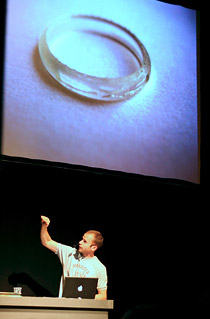 Tobie Kerridge of Biojewellery gave an overview of the project which he pursues together with Nikki Stott at the Royal College of Art and Ian Thompson of Kings College London. It’s fairly well-known so probably no need to explain it in great detail. News is that they actually found four couples who are enthusiastic about the idea of wearing a ring which partly is grown from of their partners bone and underwent surgery for getting enough samples of bone-cells to start cultivating them. They actually had their wisdom teeth removed and from the chips of jawbone which usually came off, the Biojewellery guys got enough material to start growing the bone on a scaffold, outside of the context of a body. It’s a complex process for everyone involved, both in terms of legal issues and since it will be a most personal object, the design of the rings themselves is currently being finalized together with their future owners.
Tobie Kerridge of Biojewellery gave an overview of the project which he pursues together with Nikki Stott at the Royal College of Art and Ian Thompson of Kings College London. It’s fairly well-known so probably no need to explain it in great detail. News is that they actually found four couples who are enthusiastic about the idea of wearing a ring which partly is grown from of their partners bone and underwent surgery for getting enough samples of bone-cells to start cultivating them. They actually had their wisdom teeth removed and from the chips of jawbone which usually came off, the Biojewellery guys got enough material to start growing the bone on a scaffold, outside of the context of a body. It’s a complex process for everyone involved, both in terms of legal issues and since it will be a most personal object, the design of the rings themselves is currently being finalized together with their future owners.
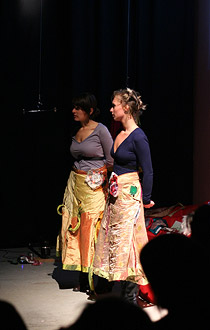 Canadian artist-researcher Thecla Schiphorst demoed her project called Exhale which basically consists of networked skirts which reflect their wearer’s breathing through LEDs attached on the outside. In her view, breath is something that gives away a lot about a person, there’s even intelligence in it and we often would connect with people though unconsciously watching them breathe. Her other project deliberately chose very soft and colorful cushion-like objects to be electronically enhanced and able to reflect the pressure that is being applied to them in various visual ways. I must say that I found her projects slightly confusing, until one of the actuators which was wirelessly connected to the Exhale-garment she was wearing, was passed to me. Holding it in my hand, I could feel her breath through an tiny motor which made for a brief but very interesting experience of being linked.
Canadian artist-researcher Thecla Schiphorst demoed her project called Exhale which basically consists of networked skirts which reflect their wearer’s breathing through LEDs attached on the outside. In her view, breath is something that gives away a lot about a person, there’s even intelligence in it and we often would connect with people though unconsciously watching them breathe. Her other project deliberately chose very soft and colorful cushion-like objects to be electronically enhanced and able to reflect the pressure that is being applied to them in various visual ways. I must say that I found her projects slightly confusing, until one of the actuators which was wirelessly connected to the Exhale-garment she was wearing, was passed to me. Holding it in my hand, I could feel her breath through an tiny motor which made for a brief but very interesting experience of being linked.
Joey Berzowska of XSLABS, maker of Kukkia, is researching in Montréal on garments which are kinetic and visually interactive. Basically, there’s two ways of achieving this, through color-change or through change of shape. Thermochromic paints are well-researched and apparently now the field of study seems to be focusing more and more on motion, often using shape-memory-alloys like Nitinol or tiny motors and pulleys (don’t miss Hussein Chalayan‘s last show). 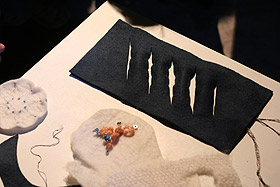 Joey’s work stays away from digital technology in favor of more simple ways of making the dress “a being in itself”, which sometimes works well with its wearer but sometimes might even work against him or her – at times “the garments are wearing you instead of you wearing the garments”. Her new project called Skorpions will continue to apply Nitinol in order to make very simple mechanical movements possible. Design studies include the (aptly-named) Anus which is a hole in a piece of fabric which is able to contract or expand. Squid is a way of knitting around the wires which turns out to be rather beautiful. The most ambitious design is Venus though, a dress which very much surrounds its wearer and can significantly change its own shape, thus shaping the wearer and also constraining her movements.
Joey’s work stays away from digital technology in favor of more simple ways of making the dress “a being in itself”, which sometimes works well with its wearer but sometimes might even work against him or her – at times “the garments are wearing you instead of you wearing the garments”. Her new project called Skorpions will continue to apply Nitinol in order to make very simple mechanical movements possible. Design studies include the (aptly-named) Anus which is a hole in a piece of fabric which is able to contract or expand. Squid is a way of knitting around the wires which turns out to be rather beautiful. The most ambitious design is Venus though, a dress which very much surrounds its wearer and can significantly change its own shape, thus shaping the wearer and also constraining her movements.
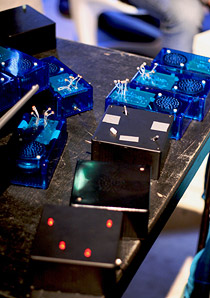 “If it sounds good and doesn’t smoke, don’t worry of you don’t understand it” is one of the mottos of Kristina Andersen who wants to introduce naïve electronics (a term borrowed from naïve physics) to the world and see how it reacts to it. She applies her techniques from kids to art students (who she gives kid’s electronics kits to) and closely observers what people make of it. Most of the time, the products of the glitches and the unexpected tends to be much more intriguing than the (due to previous experience) expected or doing it right. She recommends: “If your project makes sense to a 5-year-old, it’s probably sound.” To learn more about how little preoccupied kids are with interaction, she deliberately designed a range of truly black boxes with different properties and paradigms each. Kristina hands them to children (or the audience in this case) and watches what happens and how they (we) explore how they work with them and often come up with both correct or completely different ideas about how they operate – no knowledge in electronics preferred.
“If it sounds good and doesn’t smoke, don’t worry of you don’t understand it” is one of the mottos of Kristina Andersen who wants to introduce naïve electronics (a term borrowed from naïve physics) to the world and see how it reacts to it. She applies her techniques from kids to art students (who she gives kid’s electronics kits to) and closely observers what people make of it. Most of the time, the products of the glitches and the unexpected tends to be much more intriguing than the (due to previous experience) expected or doing it right. She recommends: “If your project makes sense to a 5-year-old, it’s probably sound.” To learn more about how little preoccupied kids are with interaction, she deliberately designed a range of truly black boxes with different properties and paradigms each. Kristina hands them to children (or the audience in this case) and watches what happens and how they (we) explore how they work with them and often come up with both correct or completely different ideas about how they operate – no knowledge in electronics preferred.
Suzanne Lee was back to briefly present her current work which is, although cut like like a plain shirt, very exciting since its fabric is completely grown by yeast and bacteria in the project BioCouture.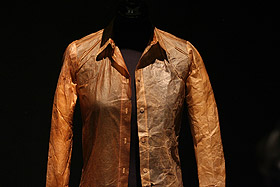 This research is still in its very early steps but they have so far learned how to cultivate the material in a sweet tea-solution, a technique which has been in use for ages in the production of Kombucha. When exposed to such an environment, the bacteria produce a material which is in between papyrus and leather with a color that can be altered through the choice of tea. (Black tea makes it more, guess what?) The shirt had a very skin-like appearance and was obviously rather fragile, but nonetheless this is an interesting start for something that promises great sustainability, especially since many of the required techniques have been in use for thousands of years, especially in poorer regions.
This research is still in its very early steps but they have so far learned how to cultivate the material in a sweet tea-solution, a technique which has been in use for ages in the production of Kombucha. When exposed to such an environment, the bacteria produce a material which is in between papyrus and leather with a color that can be altered through the choice of tea. (Black tea makes it more, guess what?) The shirt had a very skin-like appearance and was obviously rather fragile, but nonetheless this is an interesting start for something that promises great sustainability, especially since many of the required techniques have been in use for thousands of years, especially in poorer regions.
A Victimless Utopia is what Symbiotica‘s Ionat Zurr ironically envisions for our future. They make the start with the projects Victimless Meat and, more recently, Victimless Leather. We are a technologically dependant species, and not only since the notion of the Cyborg came up, we are alienating us from bodies as such. Zurr happily propose the Techno-scientific-body instead which can also be the machinery which for example hosts the gallons of bio-mass produced from cells by one single, long deceased hamster. 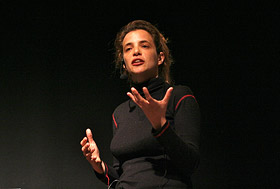
Quoting Biologist Honor Fell: “When we think something is dead, there’s a lot of life in it”, Symbiotica further research into semi-living-objects ultimately leading to their “Disembodied Cuisine” in which steaks are grown. This project, although it fell through in terms of taste, attracted a lot of attention, even from animal-rights group PETA whose leader wanted to have her own tissue grown into a steak in order to be able to eat herself. Symbiotica rejected, pointing out that the serum required for nurturing the tissue takes so many calves’ lives that it would be hardly something to promote animal rights with.
Wrapping up, the final discussion developed into a very interesting and general debate about what distinguishes art and science in the first place, fueled by the diverse approaches that the different presenters have to tackle relatively similar topics. It was argued that the thought processes in art and science are in fact very similar, but that their respective way of “fleshing out” their findings into results is where they differ. Ger Brinks from Colbond strongly disagreed while pointing out that what artists and designers deal with is a completely different thing from experimental science. What practitioners would get their hands on is very much leaned towards application, often already engineering. Closing, Anne Galloway remarked that art is romanticising itself regaining its allegedly lost power just as much as science is emphasizing on its methodology-based authority and neither standpoint in her view is completely valid. One would have to ask why these boundaries exist in the first place.
Bigger pics on Flickr

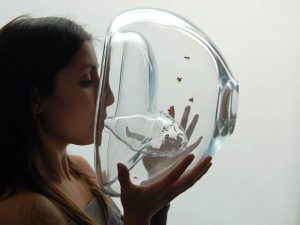
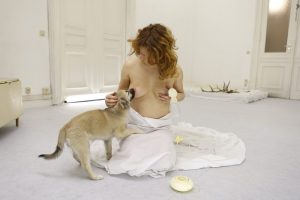
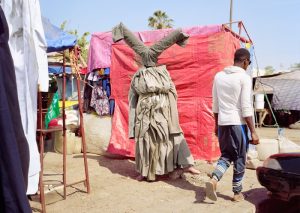
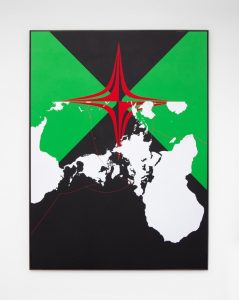
![7 art and tech ideas I discovered at Meta.Morf 2024 – [up]Loaded Bodies 7 art and tech ideas I discovered at Meta.Morf 2024 – [up]Loaded Bodies](https://we-make-money-not-art.com/wp-content/uploads/2024/05/53705969154_73dfdfea6f_c-300x200.jpeg)

